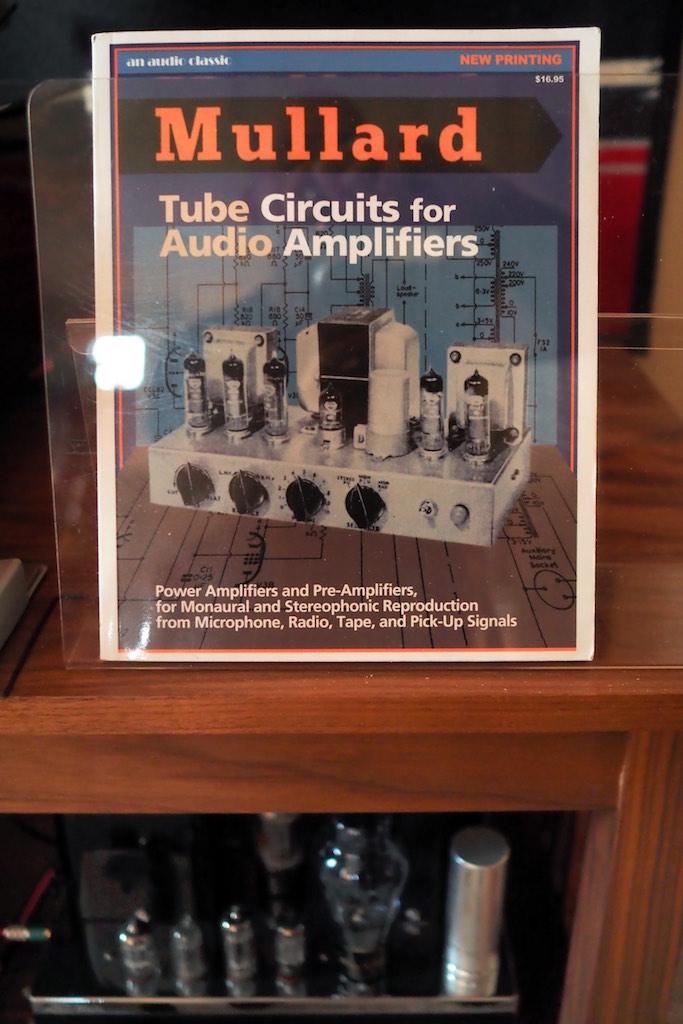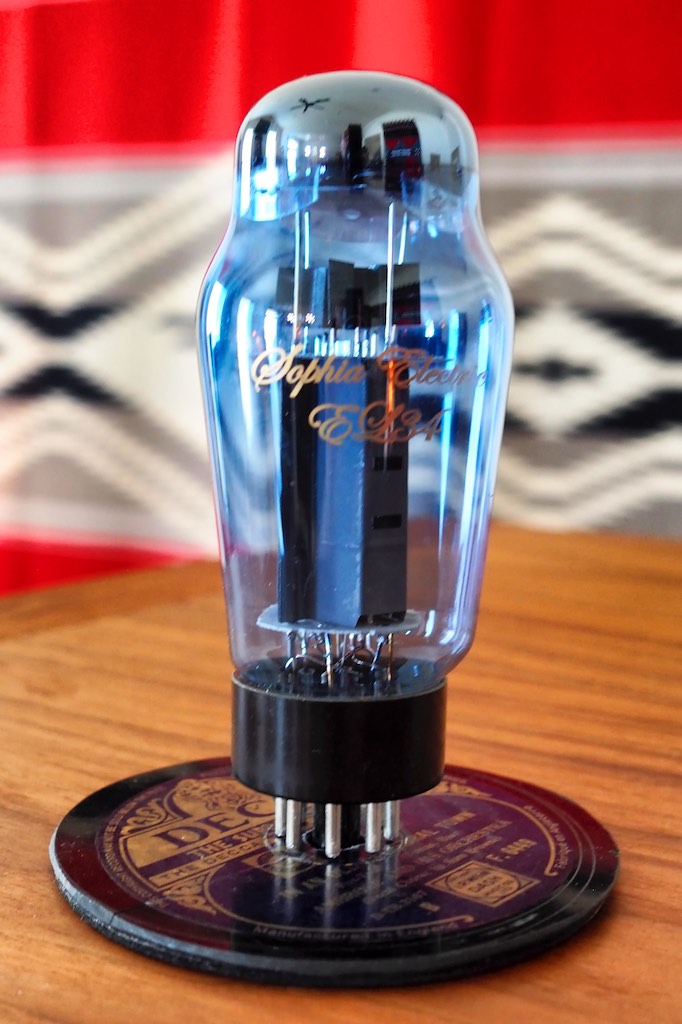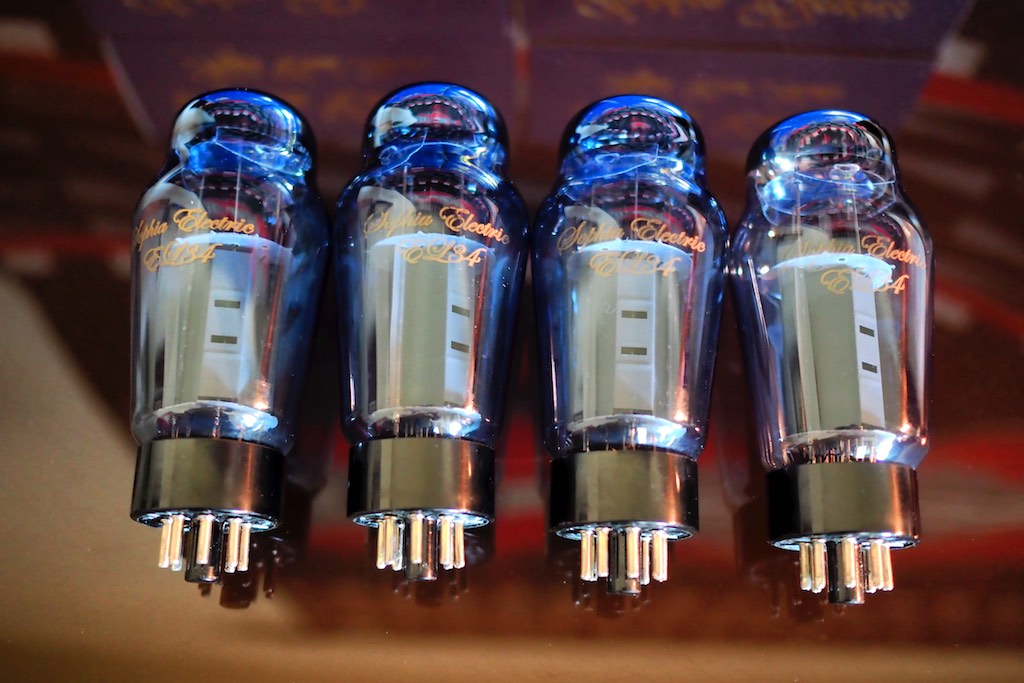I'm hard at work listening and writing this weekend for my article about the Sophia Electric EL34-ST and Aqua 274B vacuum tubes for Positive Feedback.
I hope to be finished up with the article either this or next weekend, but I thought in the meantime you might enjoy a sneak peek, so here you go!
¸¸.•*¨*•♫♪¸¸.•*¨*•♫♪¸¸.•*¨*•♫♪
Sexy Blue Tubes: The Sophia Electric EL34-ST and Aqua 274B Vacuum Tubes!
By Jeff Day
I’ve always enjoyed visiting with Richard and Sue at Sophia Electric about their vacuum tubes and amplifiers, so when Dr. David contacted me about Sue’s inquiry to see if I’d be interested in writing about the new Sophia Electric EL34-ST and Aqua 274B vacuum tubes, I said “You bet!”
I’ll start with the new Sophia Electric EL34-ST, but before I go into any details about it, I think I should begin with a little preliminary history about the EL34 style of vacuum tube, so that Richard’s goals for the Sophia Electric EL34-ST can be understood in context.
Beam power tetrode tubes like the RCA 6L6 (1936) were popular in the vacuum tube marketplace in the 1940s. The European EL34 pentode vacuum tube developed by Philips in 1949, which was the parent company of Mullard, and Mullard would release their EL34 in 1953.
It has been speculated that the development of the EL34 was a way to circumvent the patents held by America’s RCA on beam power tubes. Although, it has also been reported that RCA developed the 6L6 beam tetrode tube as a way to circumvent the even earlier Philips patent for the pentode tube design, which indicates intense corporate competition for a valuable vacuum tube market.
While there are differences in the internal construction of a 6L6 beam tetrode and an EL34 power pentode, they are functionally similar, and have a similar range of power output, but distinctly different tone, which has come to be characterized as “American tone” vs. “British tone”.
The intent of the Mullard EL34 was to produce an inexpensive tube that could achieve high power with high-sensitivity, allowing designers to develop amplification with a minimum of components to help keep costs down.
Mullard assisted designers by providing a wealth of information about incorporating their vacuum tubes into audio preamplifier and power amplifier designs in the Mullard Circuits for Audio Amplifiers (1959), which is fascinating to read, by the way.
The EL34 was rapidly embraced in for both audio and guitar amplifiers, with notable audio designs employing the EL34 like the Marantz Model 2, Model 5, Model 8A, Model 8B, and Model 9 amplifiers, and the very popular Dynaco Stereo 70. The EL34 was introduced into the guitar world when Marshall introduced it into their production guitar amplifiers, like the JTM 50 (1966) and JTM 45 (1967).
For those of you interested in learning more about EL34 vacuum tube history, I recommend you take a look at the Mullard Circuits for Audio Amplifiers, and in particular I encourage you to read Eric Barbour’s two excellent articles about the history of the EL34 vacuum tubes in Vacuum Tube Valley Issue 2 and Issue 16.
The Sophia Electric EL34-ST Vacuum Tube
I asked Richard if he’d tell us about how his Sophia Electric EL34-ST compared to the classic EL34’s, and what he’s done different.
“The origins of EL34 tubes can be traced back to Europe during the late vacuum tube era. Its creation was to fulfill the purpose of being easily mass produced during a time when cost cutting was important, and this resulted in many limitations being placed on the tubes.”
“The EL34 tube is important, because with the resurgence of vacuum tubes in the 1990s, the EL34 tubes also regained worldwide popularity in thanks to its low drive voltage requirement that was sufficient for 20-35 watts per channel of power output for home use.”
“Eastern European, Russian, and Chinese vacuum tube manufacturers have all taken the original European EL34 as the basis for their designs, and have replicated it in massive production without pondering the “whys” and “hows” of that original design.”
“The EL34 design is an industrial tube, using a straight glass pipe sliced into cylinders on the assembly line for fast production. The shape of the tube, known as GT shape, was never considered for its sound quality. In other words, by making the EL34 tubes the same way they were originally created, the quality of the sound is sacrificed for the sake of time and profit.”
“We think of Sophia Electric as an innovative American company, and thus we aim to redesign well known products like the classic EL34 design, to improve especially upon the sound quality. In the process of designing our high-performance 126S amplifier, we rediscovered the use of EL34 tubes for replacing the Western Electric 350B/6L6 in the classic WE 124 amplifier circuit that we started with. But we really wanted high-quality tubes to pair with our new amplifier, so we decided it was vital to redesign a brand new EL34 tube to create the ultimate in sonic performance for our new 126S amplifier.”
“The original EL34 tube is a pentode power tube design that is known for bright, direct, and somewhat straight-in-your-face sound. When the EL34 tube is pushed too hard it generates an excessive amount of distortion, which is good for rock & roll guitar amplifiers, but not for high-end audio amplifiers.”
“So we designed our new EL34-ST to be closer to the European KT66 family of tubes, yet we still wanted to retain the key characteristics of the original EL34 tube design. Our new design replaces the original EL34’s plain and rather uncivilized sound with a more refined and artistic sound. The EL34-ST is articulate, yet still lyrical. It has more micro-contrast in the nuance of the music, and more vividness in the 3-D stereo soundstage that audiophiles enjoy.”
“Electrically the specifications of the EL34-ST are same as the vintage Mullard, with a heater (filament) voltage of 6.3V AC, a heater current of 1.5A, a maximum plate voltage of 800V, and a maximum power dissipation of 25 watts.”
“As a result, Sophia Electric’s new EL34-ST tube is a direct replacement for vintage Telefunken and vintage British made Mullard EL34 tubes. It is also a safe direct replacement and premium upgrade choice for amplifiers currently outfitted with Chinese, Russian (the current “Mullard” is a Russian tube), and other Eastern European EL34 tubes.”
“The vintage EL34’s utilized a GT shape glass enclosure that was cheap and simple to mass produce. In the production line, each glass tube was created like a long sausage being sliced.”
“For the Sophia Electric EL34-ST we chose to use an ST shaped glass bottle similar to those used for 300B’s, which helps give the EL34-ST a 300B-esque sound. In fact, we applied much of our 300B design and manufacturing expertise in the creation of our new EL34-ST vacuum tube. The larger ST bottle shape gives our EL34-ST tubes a sound that is more airy and live-like compared to the cheap GT glass tube.”
“The blue tint that we’ve added to the glass not only looks exotic, but during the voicing process we found that the blue tint of the ST shaped enclosure added more sonic impact to the presentation of the music. Vintage US military tubes often had a black metal base and/or black-grayish smoky carbon-containing paint sprayed on the inside of the glass tubes for light shielding to reduce noise. British and German military tubes often used red paint for light shielding to reduce noise. We have auditioned various light shielding possibilities, and ultimately settled on the blue tinted glass, which when combined with ST bottle shape, provided additional musicality and a distinctly better tone.”
“Back when all vacuum tubes were placed inside a chassis, there was no need for consideration about light induced noise. However, high-performance audio enthusiasts now like to see the tubes displayed in the open, so they can see them from their listening seats, and they also enjoy seeing the glow of the filaments. The blue tint ST bottle shape is an ideal solution, as it is a beautiful and excellent sounding bottle shape, and the blue tint offers the benefit of a reduction in light induced noise, while still allowing the listener to see the beautiful glow of the filaments.”
“We are confident that those who have an EL34 amplifiers would be thrilled with this brand-new patented Sophia Electric EL34-ST tube.”
Sophia Electric offers the following pricing options for the Sophia Electric EL34-ST tubes:
Grade A (top 10%): $125 USD per tube with 30 days warranty, $25 extra for one year warranty.
Grade B (top 25%): $100 USD per tube with 30 days warranty, $25 extra for one year warranty.
As points of comparison, a matched pair of vintage EL34 Mullard nickel base tubes with an early production 1956 date code (the most desirable vintage Mullard EL34), sell for $499 USD per matched pair at Brent Jesse Recording (when available), and the new production “Mullard” (the name and trademark were acquired by New Sensor Corporation) that are manufactured in the Reflektor factory in Russia, typically sell for around $26 USD per tube.
So, the vintage 1956 Mullard EL34 at about $250 USD per tube, is about ten times more expensive than the mass production Russian Reflektor EL34 at $26 USD per tube, the new Sophia Electric EL34-ST at $125 USD per tube is about five times more expensive than the mass produced Russian Reflektor EL34 per tube, putting the Sophia Electric EL34-ST towards the middle of the pricing spectrum between current production Russian Reflektor EL34’s and the vintage 1956 Mullard EL34’s.
Sophia Electric told me that the Sophia Electric EL34-ST tubes are rated to have a mean life span of 7,000 hours, with a range of 5,000 – 10,000 hours, which translates to about a four to eight-year lifespan, with a median of just under a six-year lifespan, assuming about 1,200 hours per year of operation.
The Sophia Electric Aqua 274B Rectifier Tube
The original 274B rectifier tube was developed by the legendary Western Electric company in America. The Western Electric 274B is filamentary full-wave rectifier with an octal base that delivers direct current from an alternating current source. You can read the full specifications of the WE274B here, in the Western Electric Vacuum Tube Data Manual (1941).
I asked Richard if he would tell us about his Sophia Electric Aqua 274B rectifier tube, and how it compares to the original Western Electric 274B rectifier tube.
“Prior to Aqua 274B rectifier tube, Sophia Electric has made a number of successful 274B rectifier tubes, like the Princess 274B mesh plate, which we consider “the ultimate choice” for today’s high-end tube pre-amplifiers and headphone amplifiers, as well as for small triode (2A3/45/PX4/71A/205D/101D) tube mono-block amplifiers.”
“Our Princess 274B rigid plate rectifier tube is a true replica of the vintage Western Electric 274B rectifier tube. Many audiophile users have reported that it sounds better than the original vintage Western Electric 274B in the WE91 300B circuit, or in a modern 300B single-ended tube amplifier circuit, and at a fraction of the cost.”
“However, all traditional 274B rectifier designs (Sophia or Western Electric) have the limitation that the first capacitor in the power supply after the rectifier tube must be miniscule. For vintage Western Electric 274B rectifier tubes it can be no bigger than 4 uF, and for the Sophia Electric rigid plate and mesh plate 274B’s the limit is a slightly higher 8 uF. No matter how great those 274B tubes sound, this capacitor requirement limits 274B applications, just as it did for the original Western Electric 274B rectifier during the golden age of vintage vacuum tubes. Mainstream rectifier tubes like the 5U4 (America) and 5AR4 (Europe) permit up to 47 uF in the first capacitor position in a power supply, making them applicable to a wider variety of power supply designs.”
“So why bother with a 274B rectifier? Back in the early 1930’s Western Electric designed the WE91 cinema amplifiers that utilized the 300B tube in a single ended output circuit. The WE91 produced an output of 5.6W, which was enough to drive the cinema horn loudspeakers of the 1930’s to volume levels adequate for cinema sound reproduction. 300B tubes require about 60V RMS drive voltage to achieve their full output power of 5.6W. To accomplish this, Western Electric chose the 310A, a pentode tube, for their driver choice.”
“The pentode driver tube was an elegant choice, but it was at the expense of high frequency extension. Back then, 10KHz was considered the maximum high-frequency for high-fidelity, with movie dialog being more in the mid-range. Even so, Western Electric still wished for a little more high-frequency extension in their WE91 300B amplifier to make the sound more open and lively. This demand called for a premium long plate rectifier tube, now known as the WE 274B tube.”
“Without the 274B rectifier tubes, Western Electric tube amplifiers sounded rather dark and dull. But with the 274B, Western Electric amplifiers sounded full and complete, and were a significant sonic upgrade.”
“However, when the power supply capacitor is higher than 8 uF the long plate of the WE274B sparks, which forced Western Electric to limit the design requirement to 4 uF. This limitation prevented the 274B rectifier tubes from being used in a wide variety of applications, both in vintage times and today, as most modern equipment was designed with up to 47 uF capacitors as the first capacitor in the power supply so they could utilize 5U4G and 5AR4 rectifiers.”
“Sophia Electric has solved this limitation of the 274B in our Aqua 274B rectifier tube. Initially we tried to solve this limitation by using exotic materials, as in the design of our very popular Royal Princess 300B tubes, which utilizes platinum and rare earth materials. We were successful, but the finished product was way too expensive for the average consumer to be viable.”
“Then we went back to the WE 274B structure design as a starting point, and in an unexpected way we figured out a way to solve the Western Electric limitation of 4uF. This solution allowed us to build the Sophia Electric Aqua 274B, which can use up to a 47 uF filter capacitor value, the same maximum value permitted for 5U4 and 5AR4 rectifiers.”
“In a 300B mono-block amplifier, such as Sophia Electric’s 91-01, or the newer 91-01 Signature amplifier, the Aqua 274B can easily replace the 5U4 rectifier tube and deliver a wider and deeper soundstage, and deliver the musical magic that is otherwise missing when not using a 274B rectifier.”
Sophia Electric offers the following pricing options for their Sophia Electric Aqua 274B rectifier tubes:
Option 1: $199.99 per tube with one year warranty
Option 2: $159.99 per tube with 30 days warranty
As interesting data points, original vintage Western Electric 274B rectifiers are currently selling for $1499 USD each at Brent Jesse Recording, and the mass production Chinese Shuguang 274B rectifier sells for approximately $27 USD each on the open market.
So, a vintage Western Electric 274B rectifier sells for approximately fifty-five times the price of a mass production Chinese Shuguang 274B rectifier, and the Sophia Electric Aqua 274B rectifier sells for about six times the price of the Shuguang 274B rectifier.
Sophia Electric doesn’t have a lot of data on the lifespan of the Aqua 274B yet, as it is a new tube for them. However, based on earlier 274B rectifier track records, Sue thought it likely that it would have a 5,000 to 10,000-hour lifespan, with the caveat that the amplifier has no more than a 47 uF capacitor in the power supply after the rectifier.
If you are unsure about the value of the first capacitor in your amplifier’s power supply, ask the manufacturer about it. For example, in my vintage McIntosh MC30 monaural amplifiers, in which I’ve hot-rodded the power supply a bit in an adventure with Yazaki-san, the first capacitor after the rectifier is a 0.47 uF Arizona Capacitors "Green Cactus".
Listening Impressions
¸¸.•*¨*•♫♪¸¸.•*¨*•♫♪¸¸.•*¨*•♫♪
Ok, that's it for now, and I hope you enjoyed it!
As always, thanks for stopping by, and may the tone be with you!





































